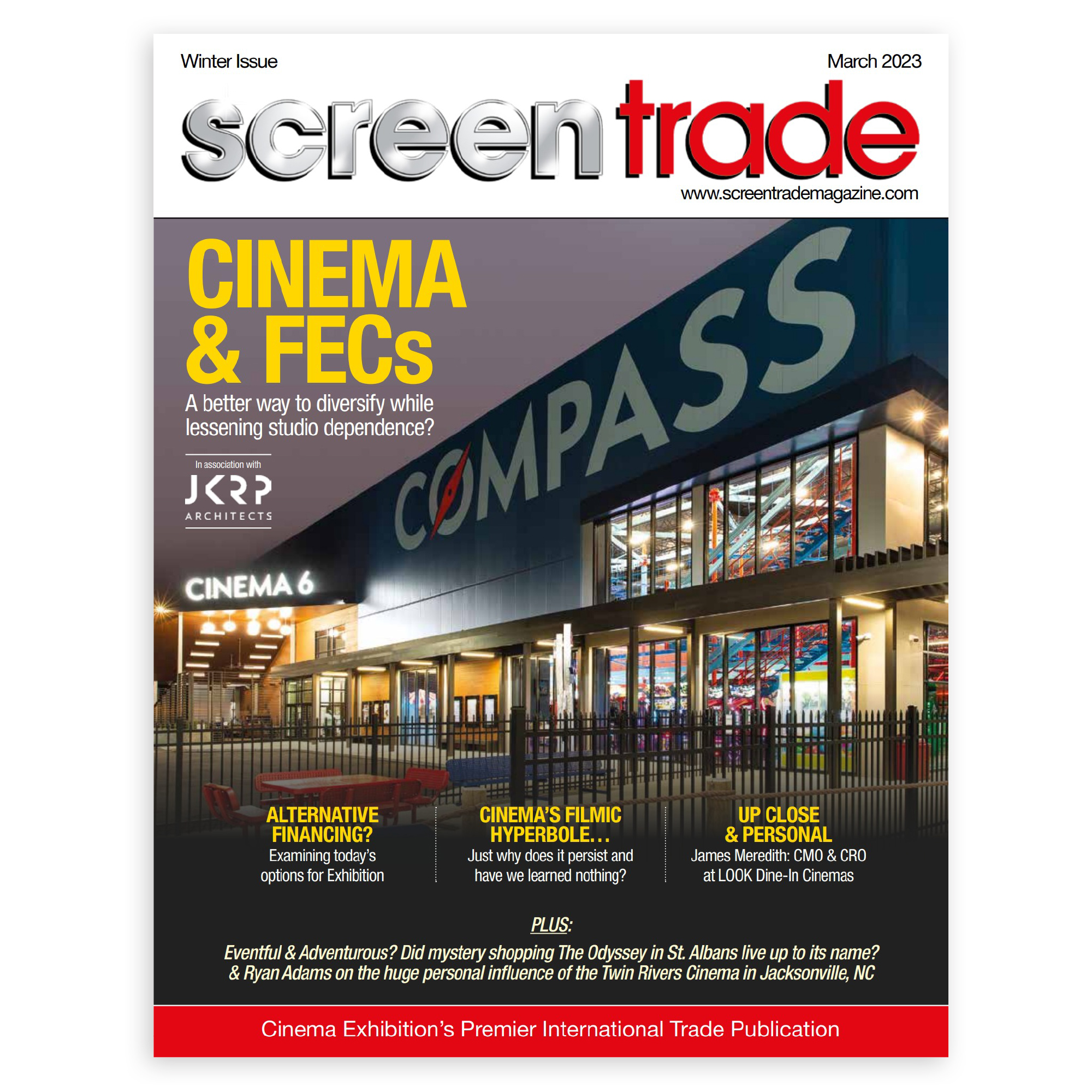Cinema & FECs – ScreenTrade Magazine
JKRP recently published an article with ScreenTrade Magazine about the growing trend in Cinema to to incorporate more entertainment options such as bowling, carting, axe throwing, games and more to stay competitive with at home streaming. The article also incudes some advice from our friends & industry leaders – David Wallace (Turfway Entertainment), Britannie Betti (Betson Enterprises), Jay Saladino (Brunswick Bowling), and Massimo Makovac (360 Karting).
Click the image below to see the full story!
Theater operators should be applauded. From a single screen to twin screens to multiplexes; from sloped floor to stadium seating; from 35mm to digital; from scope to large screen format and immersive sound; from fixed back to rocker; from rocker to recliner; from popcorn, soda, and candy to expanded menu to full dine-in and beverage service; operators have historically understood the need to evolve and enhance the guest experience, and they accepted the need to invest in these changes. Their mission has been to always stay relevant in the business of entertainment. With all these changes, there has been one constant, the movies are the primary attraction for bringing guests through their doors.
Fast forward to today… limited movie production, reduction of release windows, and expanded streaming services. All of these factors have contributed to a decline in movie theater attendance. This is the challenge. Where do operators find the solution?
Let’s start by looking at the past. Many can remember the days when most theaters included a game room, or at least an area designated for games. Whether it was pinball or video machines, air-hockey, basketball, or any of the other conventional arcade games that were available at the time, operators enjoyed the additional revenue these games generated. What if these types of attractions were reintroduced at a larger scale, expanded, and became a more significant part of the guest experience?
Let’s look at traditional Family Entertainment Centers (FEC’s) for some guidance. FEC’s have recently been growing in popularity. Along with the typical arcade games, FEC’s have expanded the activities to include bowling, laser tag, ropes courses, mini golf, electric carting, axe throwing, and full-scale dining and beverage service, just to name a handful of the many entertainment options available. All these activities serve to diversify and enhance the entertainment experience. Now, what if we consider introducing some of the elements of an FEC with a traditional movie theater. Think of bowling, electric carting, golf simulators, rock climbing or a ropes course, and dining and beverage service, if your theater does not currently offer this service. If these entertainment activities were introduced into your theater venue, imagine the buzz and excitement that they would generate. With a variety of compatible and stand-alone entertainment options to complement the theater, operators will no longer be solely dependent on movies to generate revenue.
How do you get there? You are closer than you think. First, consider what additional activities will best complement your existing movie theater. Location, demographics, competition, and desired target audience all play a part in determining the appropriate activities to include in a venue. Fortunately for operators, there are consultants who can provide this analysis and determine what activities are best suited for you. Second, consider the additional floor area needed to accommodate the new attractions and new or expanded food and beverage services. For many, the additional area will come from the conversion of underutilized auditoriums. This is particularly relevant for many multiplexes with ten or more screens as the decline in movie production and reduction of release windows have eliminated the theater operators’ need for so many auditoriums within their theater. Fortunately, the clear floor space and height of existing auditorium spaces can easily accommodate the physical requirements needed for most of the activities and services that are present in typical FEC’s. And in most cases, where expansive space is desired and multiple auditoriums are combined, the auditorium demising walls can easily be removed with little to no impact on the building’s structure. However, there are instances where the auditorium demising walls are load bearing. Although large openings can be created in these load bearing walls, it will come at a greater cost. The impact and costs associated with leveling out auditorium sloped floors or platform construction should also be considered. Lastly, consider how to seamlessly integrate the existing theater operation with the new entertainment activities. Design professionals are here to assist. The goal is to create a reciprocal relationship between the theater and FEC activities. As suggested above, any initiative by a theater operator to pursue an expanded entertainment venue should start with the assistance of experienced consultants. Every site and location are different and should be analyzed to find the right combination of attractions and to determine the extent of renovation work necessary to accommodate those attractions. It is this careful initial planning that will serve to optimize your investment.
Another important factor to consider is that once additional entertainment components are added to a movie theater venue, operators must rethink the operations and the branding of their venue. From an operations standpoint, different activities have different peak hours requiring support for those activities. In addition, the different activities tend to be supported by different food and beverage items, and the ability to serve those food and beverage items should be considered. As far as branding, operators must promote the variety of activities offered. This generally requires a reinvestment in your marketing efforts. Initially, your history as a movie theater will bring people in. Once they recognize and experience the variety of entertainment components, people will return just for that experience. Over time, this will result in a more consistent flow of guests and revenue, and won’t this address the challenges presented to movie theater operators today? Although this may not be the answer for every operator, it is certainly worth consideration.


